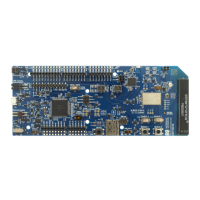3
Operating modes
The nRF9160 DK has various modes of operation.
3.1 Firmware development mode
The firmware development mode is the default with the IFMCU DISCONN switch (SW1) in the left position.
The primary interface for programming and debugging the nRF9160 DK is the USB port (J4). The USB port
is connected to an interface MCU which embeds a SEGGER J-Link-OB (On Board) debug probe.
Figure 2: nRF9160 DK firmware development mode
3.1.1 Device programming
The nRF9160 DK supports SWD programming interfaces for both onboard and off-board nRF targets.
The primary target for programming and debugging in the DK is the nRF9160. The interface MCU also
supports programming the onboard nRF52840 as well as external nRF devices fitted on a shield or through
a connector to external boards such as the user's own prototypes.
The interface MCU will automatically detect if external targets are plugged in. The PROG/DEBUG switch
(SW5) is used to select nRF9160 or nRF52840 for programming or debugging on board. Note that there
are significant limitations on using the nRF52840 on the nRF9160 DK. For more information, see nRF9160
DK board control on page 21.
3.1.2 Virtual COM port
The interface MCU also features three UART interfaces through three virtual COM ports.
The virtual COM ports are the following:
• VCOM0 – Connected to nRF9160 (default)
• VCOM1 – Connected to nRF52840 (nonconfigurable)
• VCOM2 – Not connected to nRF9160 (default)
For details on routing VCOM0 and VCOM2, see nRF9160 DK board control on page 21.
The virtual COM ports have the following features:
• Flexible baud rate settings up to 1 Mbps
• RTS/CTS-style Hardware Flow Control (HWFC) handling
4418_1216 v0.9.1
9

